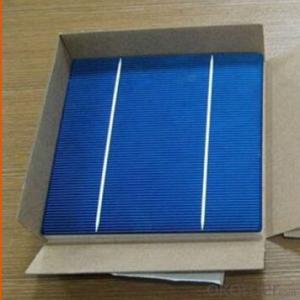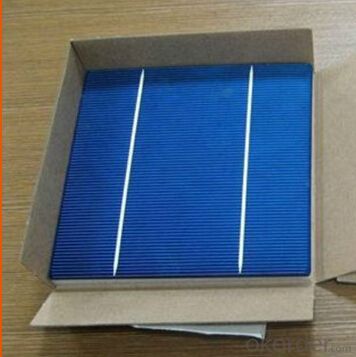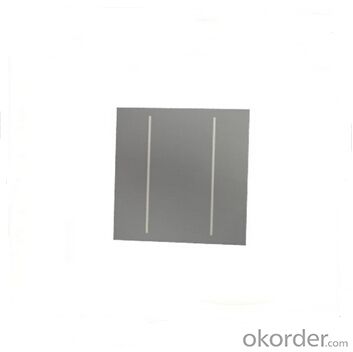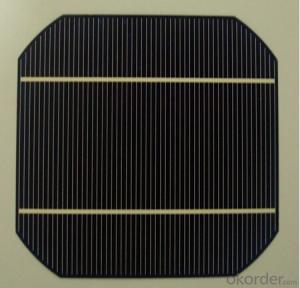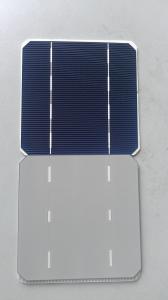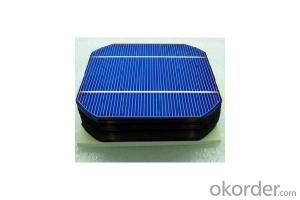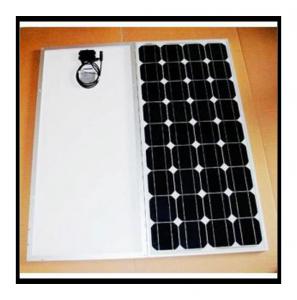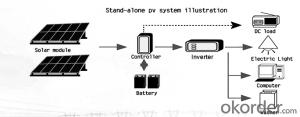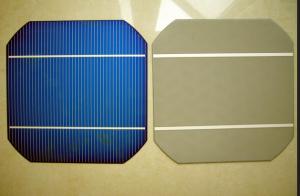Cheap Small Solar Cells - Monocrystalline Solar Cell 125mm×125mm±0.5mm
- Loading Port:
- Shanghai
- Payment Terms:
- TT OR LC
- Min Order Qty:
- 3000 PCS
- Supply Capability:
- 300000 PCS/month
OKorder Service Pledge
OKorder Financial Service
You Might Also Like
Solar Cells:
solar cells, when struck by photons of light from the sun, generates an electrical current which can then be used to power DC or AC electrical loads.
A solar cell is made of silicon. Computer chips are made of this same material. Basically, when light strikes the surface of a solar cell some of it is absorbed into the silicon. This light energy bumps the electrons loose and causes energy to flow
Solar cells is made by solar wafer, it has three categories of solar cell right now, monocrystalline polycrystalline and thin film,These cells are entirely based around the concept of PN junction, which is the critical part of solar module, it is the part that can convert the light energy into electricity, the thickness is from 180um to 200um, with even busbars to conduct electricity, textured cell can decrease diffuse reflection; they are often electrically connected and encapsulated as a module. Photovoltaic modules often have a sheet of glass on the front (sun up) side, allowing light to pass while protecting semiconductor wafers from abrasion and impact due to wind-driven debris, rain, hail, etc. Solar cells are also usually connected in series in modules, creating an additive voltage. Connecting cells in parallel will yield a higher current;With high quality and stable quality. Our Cells can greatly improve the performance of Solar Modules.
Features:
High efficiencies up to 16.4%
Proven long term mechanical stability of silicone
Make of highly purified poly silicone
Three bus bars for reduced series resistance and improved module and cell efficiency
Blue anti-reflecting coating ensures improved light absorption and increased efficiency
Acid texturization offers a uniform appearance and virtually invisible crystal structure
Excellent low light behavior for improved energy yield
Specifications
Dimension: | 125mm×125mm±0.5mm | |||||||||||
Diagonal: | 165mm±0.5mm | |||||||||||
Thickness(Si): | 200±20 μm | |||||||||||
Front(-) | Blue anti-reflecting coating (silicon nitride); | |||||||||||
1.6mmwide bus bars; | ||||||||||||
Distance between bus bars: 61mm . | ||||||||||||
Back(+) | Aluminum back surface field; | |||||||||||
2.5mm wide soldering pads; | ||||||||||||
Distance between bus bars :61mm . | ||||||||||||
Electrical Characteristics of mono solar cells 156x156 | ||||||||||||
Efficiency(%) | 19.4 | 19.2 | 19 | 18.8 | 18.6 | 18.4 | 18.2 | 18 | 17.8 | 17.6 | 17.4 | 17.2 |
Pmpp(W) | 2.97 | 2.94 | 2.91 | 2.88 | 2.85 | 2.82 | 2.79 | 2.76 | 2.73 | 2.7 | 2.67 | 2.62 |
Umpp(V) | 0.537 | 0.535 | 0.533 | 0.531 | 0.527 | 0.524 | 0.521 | 0.518 | 0.516 | 0.515 | 0.513 | 0.509 |
Impp(A) | 5.531 | 5.495 | 5.46 | 5.424 | 5.408 | 5.382 | 5.355 | 5.328 | 5.291 | 5.243 | 5.195 | 4.147 |
Uoc(V) | 0.637 | 0.637 | 0.636 | 0.635 | 0.633 | 0.63 | 0.629 | 0.629 | 0.628 | 0.626 | 0.626 | 0.625 |
Isc(A) | 5.888 | 5.876 | 5.862 | 5.848 | 5.839 | 5.826 | 5.809 | 5.791 | 5.779 | 5.756 | 5.293 | 5.144 |
Solar Cells Advantage:
1. High efficiency and High power.
2. Long-term electrical stability.
3. Lowest price and Fastest delivery.
4. Good quality and good service.
5.Bulk supply
6. Good Warranty
7.Big Sale
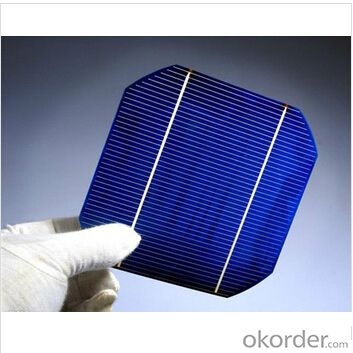
FAQ
We have organized several common questions for our clients,may help you sincerely:
1, What’s price per product ?
A: It’s depends on the quantity, delivery date and payment terms of the order. We can talk further about the detail price issue. Our products is high quality with lower price level.
2, How to make payment?
We accept T/T or L/C.
3, What is your lead time?
Generally 1-5 weeks depends on the order quantity and your specific requirements.
4, Can you do OEM for us?
Yes, we can.
5, How do you pack your products?
We have rich experience on how to pack the panels to make sure the safety on shipment when it arrives at the destination.
- Q: How long is the long cycle solar cell life?
- A look at the application of the environment, if the ambient temperature is high, then in general, to 25 degrees as a benchmark, each increased by 10 degrees, life-span reduced by half;
- Q: Can solar cells be used at night?
- No, solar cells cannot be used at night as they rely on sunlight to generate electricity.
- Q: Can solar cells be used to power water purification systems?
- Yes, solar cells can be used to power water purification systems. Solar cells convert sunlight into electricity, which can be used to power various devices, including water purification systems. This sustainable and renewable energy source is often utilized in remote areas or during emergencies where access to electricity may be limited.
- Q: How long does it take to install solar cells on a rooftop?
- The installation time for solar cells on a rooftop can vary depending on various factors such as the size of the system, complexity of the installation, and the experience of the installation team. However, on average, a typical residential installation can take anywhere from one to three days.
- Q: What is a thin-film solar cell?
- A thin-film solar cell is a type of solar cell that is made using very thin layers of semiconductor materials. These layers are typically only a few micrometers thick, which makes the solar cell much lighter and more flexible compared to traditional solar cells. Thin-film solar cells are less efficient at converting sunlight into electricity but are more cost-effective and can be used in a wider range of applications.
- Q: Can solar cells be used on satellites?
- Yes, solar cells can be used on satellites. In fact, they are commonly used as the primary source of power for satellites in space.
- Q: What are the environmental impacts of solar cell production?
- The production of solar cells does have some environmental impacts, but they are generally considered to be relatively low compared to other forms of energy production. Some key impacts include the extraction and processing of raw materials, such as silicon and metals, which can result in habitat destruction and water pollution. Additionally, the manufacturing process itself requires energy and water, which can contribute to greenhouse gas emissions and water scarcity. However, when considering the overall life cycle of solar cells, including their use and end-of-life disposal, they still have a significantly lower carbon footprint and environmental impact compared to fossil fuel-based energy sources.
- Q: What are the different sizes of solar cells?
- Solar cells come in various sizes, ranging from small portable panels for charging devices to large-scale installations used in solar farms. The sizes of solar cells can vary based on the specific application and power output requirements.
- Q: Can solar cells be used in telecommunications systems?
- Yes, solar cells can be used in telecommunications systems. Solar cells are capable of converting sunlight into electricity, which can power various telecommunications equipment such as base stations, repeaters, and remote monitoring systems. This allows for reliable and independent power supply in remote areas or during power outages, making solar cells an energy-efficient and sustainable solution for telecommunications systems.
- Q: Do solar cells require maintenance?
- Yes, solar cells do require some maintenance. Regular cleaning of the solar panels to remove dust, debris, or any shading objects is necessary to ensure optimal sunlight absorption. Additionally, occasional inspection and maintenance of the electrical connections, inverters, and batteries (if present) may be required to ensure efficient and uninterrupted operation.
Send your message to us
Cheap Small Solar Cells - Monocrystalline Solar Cell 125mm×125mm±0.5mm
- Loading Port:
- Shanghai
- Payment Terms:
- TT OR LC
- Min Order Qty:
- 3000 PCS
- Supply Capability:
- 300000 PCS/month
OKorder Service Pledge
OKorder Financial Service
Similar products
Hot products
Hot Searches
Related keywords
